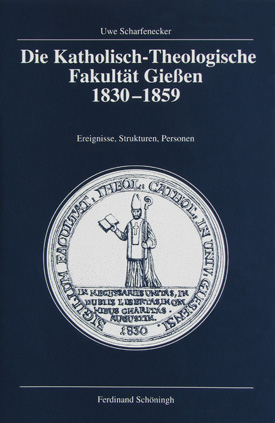Scharfenecker, Uwe: Die Katholisch-Theologische Fakultät Gießen (1830–1859). Ereignisse, Strukturen, Personen, Paderborn [u. a.] 1998

The reorganization of the Catholic Church in Germany following the Congress of Vienna (1814–1815) occasioned significant changes in the training of priests. Numerous educational institutions of the old Reich Church succumbed to secularization, while some previously all-Protestant states now saw themselves faced with the issue of training clergy for their newly-acquired Catholic subjects. In accordance with the Frankfurt Kirchenpragmatik of 1820, which was supported by many, especially southwest German federal states, the Grand Duke of Hesse-Darmstadt in 1830 founded a Catholic theological faculty at his state university in Giessen. This reform also reduced the activities of the clerical seminary in Mainz, which until then had included theological training, to the direct preparation of priests for their ordination.
The Giessen faculty was not predestined for a long existence, however. In 1859, it underwent a de facto dissolution. When Bishop Wilhelm Emmanuel von Ketteler opened a new educational institute within the Mainz seminary in 1851, no further students came to Giessen. This development hit the faculty there all the harder, considering how rapidly it had established itself at the university and contributed decisively to its modernization (in the sense of scholarly productivity). In the 1830s, the Giessen faculty featured the outstanding theologians Franz Anton Staudenmaier and Johann Evangelist Kuhn. The next decade accordingly brought a significant rise in the number of students, a trend that continued through and beyond the crisis into which the entire university plunged in the revolutionary year 1848. The Darmstadt government’s tolerance for Bishop Ketteler’s decision, however, sealed the Giessen faculty’s fate.
Relying on a broad source base, the author presents the history of the Catholic Theological Seminary at Giessen, an institution caught between competing conceptions of theological education (»tridentine seminar« versus »state faculty«). Far-reaching changes in the relationship between church and state provide the background to these events, whereby the confrontations that accompanied Leopold Schmid’s election as Bishop of Mainz in 1849 receive special attention. Scharfenecker describes the Giessen professors’ lives and theological achievements in comprehensive biographical sketches, while the social status of the students and everyday life at the Giessen faculty also receive intensive examination.
To order our publications, please, contact your local bookshop or the publishing house Schöningh in Paderborn.
